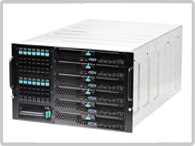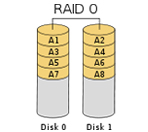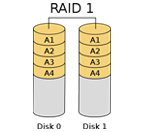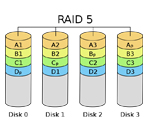Raid Data Recovery
Data Recovery Man can expertly evaluate and recover your failed RAID server or RAID device. We offer professional raid data recovery services for all levels of RAID configuration. Whether you have a RAID 1 stripe in your desktop or a damage RAID 5 server our Costa Mesa Office can help you.
Raid recovery is available for RAID levels 0,1,0+1,5,6 and 10 for all known file systems. We have experienced RAID recovery technicians who can first determine the type of failure and give you a flat rate for getting your data back. Some RAID recovery companies charge expensive surcharges or priority recovery fees. We always work on your RAID device under a priority status until the recovery is completed. Data Recovery, Done Right!™

- + Fast Evaluation Times at no Extra Cost
+ $299 Fixed rate per disk for logical raid failure (ANY RAID LEVEL)
+ Professional RAID Technicians with High Success Rates
+ No Data, No Recovery Fee
It is particularly important in a RAID data Recovery scenario that you allow only an experienced recovery company such to work on your Server or RAID device. If the disks are worked on incorrectly it is possible to destroy the data sets making the recovery of data impossible. For example if a hard-drive in a typical computer is formatted the likely hood of data recovery is fair to good; if you format or work on any individual drive in a RAID set without the proper tools you could easily make the likelihood or recovering any data impossible. Unfortunately we have received plenty of RAID devices that have been incorrectly worked on making RAID data recovery impossible. Let us look at your RAID server first greatly increasing your chances of getting your data back.
Please email us with your RAID questions at help@datarecoveryman.com
Definition:
A RAID (Redundant Array of Inexpensive Disks) device is a collection of hard-drives working together into a single logical unit (known as a container) using special hardware or software. Different levels or RAID can provide benefits over a single drive system, the main one being drive redundancy; in other words the ability to withstand a loss of one or more drive without data loss.
Common Levels:
RAID 0
RAID 0 (Stripe) moves data across multiple disks in a way that gives improved speed at any given instant. This configuration requires a minimum of two disks but if one disk fails, however, all of the data on the array will be lost, as there is no redundancy.

RAID 1
RAID 1 (Mirror) copies or mirrors the contents from one disk to another in a form of 1:1 ratio real-time backup. The contents of each disk in the array are identical to that of every other disk in the array. A RAID 1 array requires a minimum of two drives. If one of the single drives fails the other drive typically through the hardware or software device will allow the system to function normally.

RAID 5
RAID 5 is a striped set with parity. This level incorporates the benefit of increased speed and redundancy allowing for a single drive failure. Upon drive failure, any subsequent reads / writes can be calculated from the distributed parity otherwise known as “running in redundant mode” and will result in reduced performance of the entire set until the failed drive has been replaced and rebuilt. The array will have data loss in the event of a second drive failure and is vulnerable until the data that was on the failed drive is rebuilt onto a replacement drive. This array type requires a minimum of three disks and is still the most common array type in Servers and RAID devices used today.

Other RAID Levels DataRecoveryMan can service:
RAID 6
RAID 6 (striped disks with dual parity) combines four or more disks in a way that protects data against loss of any two disks.
RAID 10
RAID 1+0 (or 10) is a combination of a mirrored set (RAID 1) and a striped set (RAID 0) A RAID 1+0 array requires a minimum of four drives: two mirrored drives to hold half of the striped data, plus another two mirrored for the other half of the data.
RAID 01
RAID 0+1 is a striped data set (RAID 0) which is then mirrored (RAID 1). A RAID 0+1 array requires a minimum of four drives: two to hold the striped data, plus another two to mirror the first pair.

Data Recovery, Done Right!™
714-361-2650

